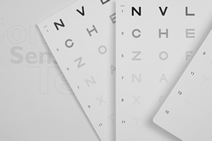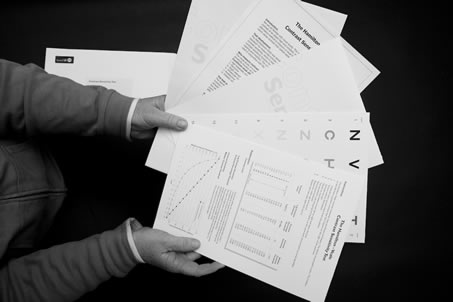TEST
YOUR OWN EYES
Seeing
is our most important sense. About 80% of all our knowledge
and management of daily life skills, are done by our
vision. All medical doctors include a visual check,
and in developed countries, vision is tested from birth,
right through life, regularly. As we age, vision in
general deteriorates. As a result, Eye Specialists recommend
regular eye checks. These will include:
1. Refraction – calculation of the power of the
eyes.
2. Media examination – to check for cataracts and
other opacities.
3. Fundii examination – to observe the integrity
of the back of the eye.
4. Intraocular pressure – to exclude glaucoma or
the possible development of glaucoma.
And,
of course, the eyes ability to see.
Distance
Vision is checked by a Snellen Chart. Each eye is
checked to record the smallest letters seen.
Near
Vision is checked on a chart like the Rose-Blackbirds
near chart.
Distortion
of Vision is checked on an Amsler Chart.
These
three important eye tests are available on the Hamilton-Veale
Eye Test. It can be used by General Practitioners,
Doctors, Nurses, School Teachers, People working with
older folk, or by yourself.
The
chart is simple to use:
The
3-metre Distance Chart should be placed at three
metres or 10 feet. Hold your hand over one eye and read
down to the smallest line. Record the letter under the
line achieved, I.E. 9=6/9 12=6/12. Read down with the
other eye and record, then do the same with both eyes
looking.

The
Log MAR Reading Test should be done holding the
chart in your hands at your normal reading distance.
Test each eye, covering the other and reading to the
smallest row seen. Record the N level, for example,
N8 right, N12 left, N8 both eyes.

The
Amsler Grid Eye Chart should be used to test
distortion of vision in each eye individually. Look
closely at the spot in the centre of the grid. If there
is any distortion observed at all, an immediate eye
examination is essential. Distortion of the lines will
often indicate retinal changes and that could be due
to numerous causes and especially macular changes. If
the lines are grey or there are blank areas on the grid,
media opacities or field loss, could be the cause. Immediate
consultation with your Eye Specialist is essential.
Urgent self referral may save your vision.

Cataracts
If you have been diagnosed with cataracts, a drop in
your ability to see as clearly from your last eye test,
may indicate that the cataract has got worse.
Macular
Degeneration
If there is a drop in visual acuity at distance or near,
or there is distortion or shadows on the Amsler Chart,
an urgent Eye Specialists consultation is necessary.
Glaucoma
Regular eye checks are required if glaucoma is diagnosed,
but if there is a loss of visual acuity or greyness
observed when testing on the Hamilton-Veale Eye Test,
an urgent consultation with your Eye Specialist is recommended.
Refraction
As we age, all of us will have a change in the power
of the eyes. A power anomaly will result in poor visual
acuity and this can be detected by the Hamilton-Veale
Eye Test, and an optometrist eye examination is indicated.
Diabetic
Retinopathy
Can lead to a loss of visual acuity and distortion on
the Amsler Gold Eye Chart and an urgent consultation
with an Eye Specialist is essential.
Test your Own Eyes
Why test my own eyes? Eye examinations are expensive.
However, they are the only way a diagnosis can be made,
which would lead to treating the visual problem.
There is no harm done testing your own eyes regularly,
as if deterioration is noticed, and an Eye Specialist’s
consultation sort, you may save your sight. It is well
recognised that the earlier a diagnosis or help is sort,
the more chance that sight can be saved.
If you are concerned about a loss of vision, now or
in the future, you should test your eyes from time to
time. It is important to record your finding. On the
calendar is a good place. If a change or loss in vision
is detected, a prompt call to your Eye Specialist is
advised. In that way your vision could be saved. Many
people do not notice a loss in one eye, so test each
eye individually.
The Hamilton-Veale Eye Test

Test
your eyes at home with a professional kit containing;
Distance
Vision Test
This is a 3 metre/10feet Snellen visual acuity test.
This test is the same all eye doctors and general practices
use. Set it up at home or your consulting room at a
distance of 10 feet. Cover one eye and read to the lowest
row of letters. The row of letter has a number beneath.
Record this number, then test the other eye. Record,
then test and record looking with both eyes.
6/6 = 20/20 6/9=20/30 6/12=20/40 6/18=20/60 6/24=20/80
6/60=20/200
A loss in one line in Visual Acuity is significant and
urgent eye specialist appointment should be made.
Near
Vision
The
Rose-Blackbirds LogMAR near vision test is used around
to the world. It is used to calculator the reading power
required for people with presbyopia and those over 40
years of age.
It is also used by the Low Vision profession to calculate
the magnification needed to read comfortably.
The rule of thumb is that one needs to see the N5 or
0.4 logMAR to read newsprint.
Test each eye individually then together. If there is
a difference between eyes or N5 is not seen, an eye
specialist's consultation is recommended. If a loss
of vision of 2 lines on the Rose-Blackbirds chart is
noticed and urgent appointment should be made with an
eye specialist.
Macular
Check
If there is a drop in visual acuity at distance or near,
or there is distortion or shadows on the Amsler Chart,
an urgent Eye Specialists consultation is necessary.
A macular degeneration check is essential for any people
over 60 years of age.
The
Hamilton-Veale Eye Test is an essential set for;
All Doctors, use in consulting rooms, home and rest
home visits and by people who want to test their own
vision.
The
Hamilton Veale
Home Eye Test
 |
Home
Eye Test - Only
$89 USD
FREE
shipping on all orders
100% Satisfaction Guaranteed.
|
|
Test
your own eyes at home for cateracts, glaucoma, and macula
degeneration.
If
you have been told by your eye specialist that you are
developing cataracts, or have glaucoma, or macular degeneration,
the Hamilton-Veale contrast
sensitivity test is an essential way to monitor
changes in the condition of your eyes.

Save
Money.
The
Hamilton-Veale Contrast Sensitivity Test will save you
money. If you find your level of contrast recorded remains
the same, there is probably no need to visit your eye
specialist. However, if there is a change detected on
testing your eyes with the Hamilton-Veale contrast sensitivity
chart, an immediate eye examination by your specialist
is advised.
How
bad are my cataracts?
People
with normal vision can see to level 13 on the Hamilton-Veale
Contrast Sensitivity Chart and some with exceptional
vision, to level 15.
As an eye condition deteriorates, the level number will
decrease. When the level recorded is between 9 and 12,
a further eye examination by your eye specialist is
advised.
Testing
yourself for glaucoma and macular degeneration. Record
your results.
A
simple record of regular results made from testing with
the Hamilton-Veale Contrast sensitivity Chart will indicate
stability of your eye condition or deterioration. There
may be minor fluctuations of the results due to: testing
time of the day, lighting and how you are feeling. If
there are fluctuations test daily, until a stable result
is recorded. If there is a consistent deterioration,
consult your eye specialist immediately. Take the chart
and results with you, when you consult your eye specialist,
so that they can see the reason for your visit.
Remember,
the test does not compensate for a thorough eye examination.
Our
Home Test Kit is the affordable and easy to use solution
for testing your own eyes to find evidence of cataracts,
glaucoma or macular degeneration.
The Home Test Kit includes one Hamilton-Veale Contrast
Sensitivity Test, usage instructions, and a sheet for
keeping a record of your level and progress.
The
Hamilton Veale
Contrast Sensitivity
Test
 |
Contrast Sensitivity Test - Only
$89 USD
FREE
shipping on all orders
100% Satisfaction Guaranteed.
|
|
What
is a Contrast sensitivity
test
A contrast sensitivity test, checks for the ability
to differentiate between light and dark (contrast).
This ability, is as much an important sense as 20/20,
allowing us to be able to carry out everyday tasks safely.
The
Hamilton-Veale Contrast Sensitivity Test
(photo below), is an effective means of monitoring potential
decreases in contrast sensitivity function over time.
Even though a person is provided with the best possible
refraction (glasses, etc...) they may still complain
of not seeing clearly. This problem is often related
to a loss of
contrast sensitivity.

The
Hamilton-Veale Contrast Sensitivity Chart - Complete
Solution |

|

